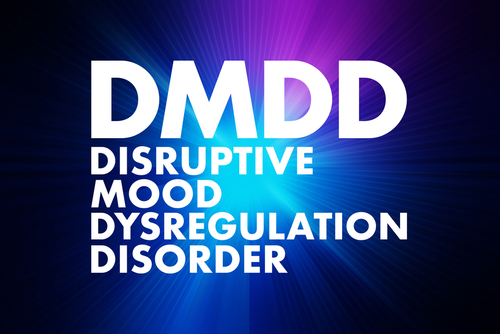Disruptive mood dysregulation disorder (DMDD) is a relatively new condition that was added to the latest edition of the Diagnostic and Statistical Manual of Mental Disorders, Fifth Edition (DSM-5) in 2013. Although there is a lack of empirical data on DMDD, the American Psychiatric Association (APA) decided to include DMDD in the DSM-5 to help address rising concerns regarding the over-diagnosis and treatment of bipolar disorder in children. DMDD is characterized as disruptive “behavior that is considered outside of the normal range of childhood behavior; the major features of this disorder include severe recurrent temper outbursts manifested verbally (e.g., verbal rages) and/ or behaviorally (e.g., physical aggression toward people or property) that are grossly out of proportion in intensity or duration to the situation or provocation.” To be diagnosed with disruptive mood dysregulation disorder, a child must be between the ages of six and 18, and the age of onset must occur before age 10. The research on the efficacy of treatment modalities for DMDD is lacking, as it is a new diagnosis. Therefore, treatment for DMDD is generally informed by methods that have been helpful for conditions that share some of the same symptoms including oppositional defiant disorder (ODD) and attention-deficit hyperactivity disorder (ADHD).
Dialectical Behavior Therapy
Dialectical behavior therapy is an evidence-based psychotherapy approach. It was developed in the late 1980s by Marsha M. Linehan, who was at the time a psychology/ suicide researcher at the University of Washington, as a means to help better treat chronically suicidal individuals diagnosed with borderline personality disorder (BPD). DBT is founded on the principles of cognitive-behavioral therapy (CBT), utilizing standard CBT techniques for emotional regulation and reality testing, and combines
concepts derived from Buddhist meditative practice such as awareness, mindfulness, and attentiveness to current situations and emotional experiences to encourage acceptance. Dialectical behavior therapy focuses on teaching four behavioral skill modules: core mindfulness, distress tolerance, interpersonal effectiveness, and emotion regulation. DBT is comprised of three different therapy settings, including weekly individual psychotherapy sessions, weekly group DBT skills therapy sessions, and as-needed phone coaching to provide additional support between weekly individual and group sessions.
DBT-C for DMDD
DBT for children (DBT-C) is an adapted version of standard DBT that is specifically geared towards treating pre-adolescent children. According to Behavioral Tech, DBT-C was developed to “address treatment needs of pre-adolescent children with severe emotional dysregulation and corresponding behavioral discontrol.” Emotional dysregulation is a term used within the mental health field to denote irrational, poorly modulated emotional responses. DBT-C has proven to be a successful treatment method for children experiencing a variety of mental health illnesses, including disruptive mood dysregulation disorder, as the core feature of DMDD is chronic, severe persistent irritability accompanied by severe temper outbursts.
DBT-C relies on the same principles, theoretical model, and therapeutic strategies of standard DBT. The DBT-C curriculum is re-framed in a way that considers and accommodates the developmental and cognitive levels of pre-adolescent children and provides age-appropriate services. Through DBT-C a child diagnosed with DMDD will learn a variety of adaptive coping skills and effective problem-solving strategies. Like standard DBT, the components of DBT for children and preadolescents include individual therapy, group skills training sessions, working directly with parents, and as-needed 24-hour phone coaching to provide additional support to children and their families. The main difference is that the treatment target hierarchy in DBT-C has been greatly expanded to incorporate an emphasis on the parental role in attaining a child’s treatment goals, by helping parents learn how to create a supportive, validating, and stabilizing environment.
The information above is provided for the use of informational purposes only. The above content is not to be substituted for professional advice, diagnosis, or treatment, as in no way is it intended as an attempt to practice medicine, give specific medical advice, including, without limitation, advice concerning the topic of mental health. As such, please do not use any material provided above to disregard professional advice or delay seeking treatment.


